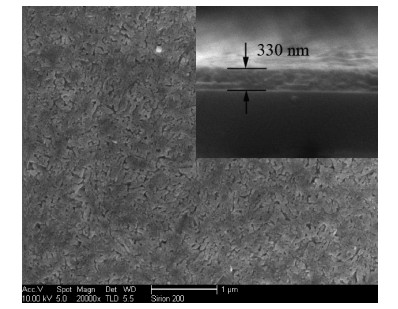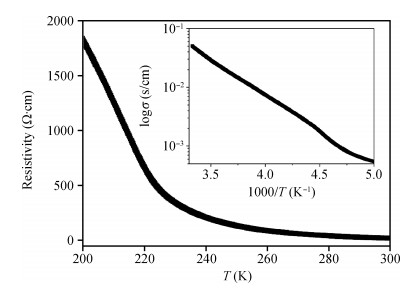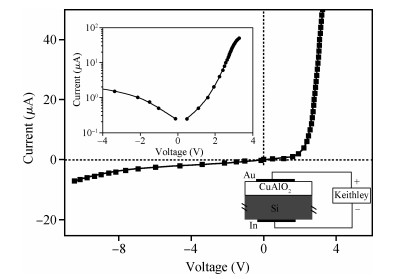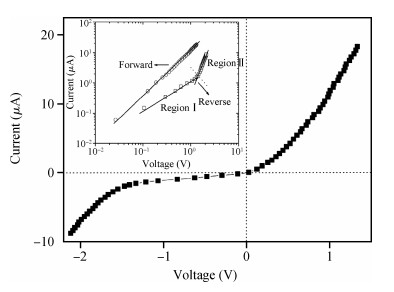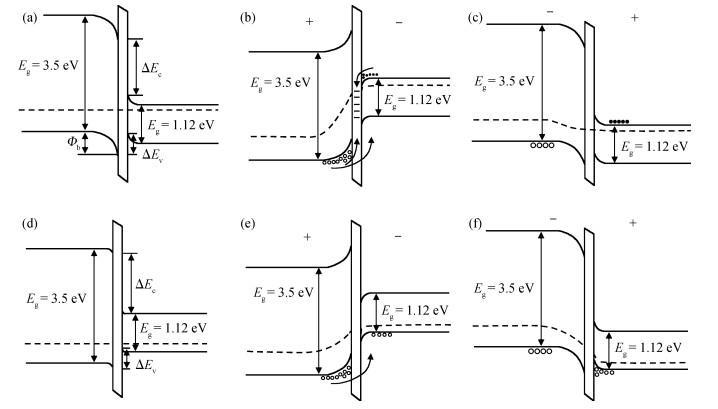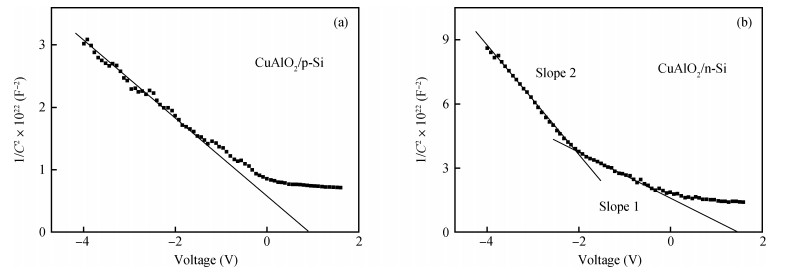| Citation: |
Suzhen Wu, Zanhong Deng, Weiwei Dong, Jingzhen Shao, Xiaodong Fang. Fabrication and electrical properties of p-CuAlO2/(n-, p-)Si heterojunctions[J]. Journal of Semiconductors, 2014, 35(4): 043001. doi: 10.1088/1674-4926/35/4/043001
****
S Z Wu, Z H Deng, W W Dong, J Z Shao, X D Fang. Fabrication and electrical properties of p-CuAlO2/(n-, p-)Si heterojunctions[J]. J. Semicond., 2014, 35(4): 043001. doi: 10.1088/1674-4926/35/4/043001.
|
Fabrication and electrical properties of p-CuAlO2/(n-, p-)Si heterojunctions
DOI: 10.1088/1674-4926/35/4/043001
More Information
-
Abstract
CuAlO2 thin films have been prepared by the chemical solution deposition method on both n-Si and p-Si substrates. X-ray diffraction analysis indicates that the obtained CuAlO2 films have a single delafossite structure. The current transport properties of the resultant p-CuAlO2/n-Si and p-CuAlO2/p-Si heterojunctions are investigated by current-voltage measurements. The p-CuAlO2/n-Si has a rectifying ratio of~35 within the applied voltages of -3.0 to +3.0 V, while the p-CuAlO2/p-Si shows Schottky diode-like characteristics, dominated in forward bias by the flow of space-charge-limited current.-
Keywords:
- CuAlO2,
- heterojunction,
- current-voltage characteristic
-
References
[1] Kawazoe H, Yasukawa M, Hyodo H, et al. P-type electrical conduction in transparent thin films of CuAlO2. Nature, 1997, 389(45):939 http://www.doc88.com/p-97836672960.html[2] Tate J, Ju H L, Moon J C, et al. Origin of p-type conduction in single-crystal CuAlO2. Phys Rev B, 2009, 80(16):165206 doi: 10.1103/PhysRevB.80.165206[3] Dittrich T, Dloczik L, Guminskaya T, et al. Photovoltage characterization of CuAlO2 crystallites. Appl Phys Lett, 2004, 85(5):742 doi: 10.1063/1.1776611[4] Zheng X G, Taniguchi K, Takahashi A, et al. Room temperature sensing of ozone by transparent p-type semiconductor CuAlO2. Appl Phys Lett, 2004, 85(10):1728 doi: 10.1063/1.1784888[5] Banerjee A N, Chattopadhyay K K. Low-threshold field emission from transparent p-type conducting CuAlO2 thin film prepared by dc sputtering. Appl Surf Sci, 2004, 225:243 doi: 10.1016/j.apsusc.2003.10.009[6] Banerjee A N, Nandy S, Ghosh C K, et al. Fabrication and characterization of all-oxide heterojunction p-CuAlO2+x/n-Zn1-xAlxO transparent diode for potential application in "invisible electronics". Thin Solid Films, 2007, 515:7324 doi: 10.1016/j.tsf.2007.02.087[7] Chi C T, Cheng I C, Chen J Z. Bandgap tuning of MgZnO in flexible transparent n+-ZnO:Al/n-MgZnO/p-CuAlOx:Ca diodes on polyethylene terephthalate substrates. J Alloys Compd, 2012, 544:111 doi: 10.1016/j.jallcom.2012.08.004[8] Banerjee A N, Joo S W, Min B K. Quantum size effect in the photoluminescence properties of p-type semiconducting transparent CuAlO2 nanoparticles. J Appl Phys, 2012, 112(11):114329 doi: 10.1063/1.4768933[9] Banerjee A N, Maity R, Ghosh P K, et al. Thermoelectric properties and electrical characteristics of sputter-deposited p-CuAlO2 thin films. Thin Solid Films, 2005, 474(1/2):261 http://www.academia.edu/7378812/Thermoelectric_properties_and_electrical_characteristics_of_sputter-deposited_p-CuAlO2_thin_films[10] Koriche N, Bouguelia A, Aider A, et al. Photocatalytic hydrogen evolution over delafossite CuAlO2. Int J Hydrogen Energ, 2005, 30(7):693 doi: 10.1016/j.ijhydene.2004.06.011[11] Ling B, Zhao J L, Sun X W, et al. Color tunable light-emitting diodes based on p+-Si/p-CuAlO2/n-ZnO nanorod array heterojunctions. Appl Phys Lett, 2010, 97(1):013101 doi: 10.1063/1.3459963[12] Ling B, Sun X W, Zhao J L, et al. Electroluminescence from a n-ZnO nanorod/p-CuAlO2 heterojunction light-emitting diode. Physica E, 2009, 41:635 doi: 10.1016/j.physe.2008.10.017[13] Zhao Yiping, Dong Weiwei, Fang Xiaodong, et al. P-type Ca doped SrCu2O2 thin film:synthesis, optical property and photovoltaic application. J Alloys Compd, 2012, 513:50 doi: 10.1016/j.jallcom.2011.09.067[14] Dong G B, Zhang M, Lan W, et al. Synthesis and characteristics of p-CuAlO2/n-Si heterostructure. J Mater Sci:Mater Electron, 2009, 20:193 doi: 10.1007/s10854-008-9697-y[15] Dong G B, Zhang M, Li Y C, et al. Synthesis and electrical properties of p-CuCr0.91Mg0.09O2/n-Si p-n junction. Chin J Nonferrous Met, 2013, 23(1):128 doi: 10.1016/S1003-6326(13)62438-3[16] Deng Z H, Fang X D, Tao R H, et al. The influence of growth temperature and oxygen on the phase compositions of CuAlO2 thin films prepared by pulsed laser deposition. J Alloys Compd, 2008, 466(1/2):408 http://cat.inist.fr/?aModele=afficheN&cpsidt=20751077[17] Deng Z H, Fang X D, Tao R H, et al. Effect of Cu excess on the electrical properties of CuxAlO2 (1≤ x ≤ 1.06). Journal of Semiconductors, 2008, 29(6):1052[18] Deng Z H, Zhu X B, Tao R H, et al. Synthesis of CuAlO2 ceramics using sol-gel. Mater Lett, 2007, 61(3):686 doi: 10.1016/j.matlet.2006.05.042[19] Li G, Zhu X B, Lei H C, et al. Preparation and characterization of CuAlO2 transparent thin films prepared by chemical solution deposition method. J Sol-Gel Sci Technol, 2010, 53:641 doi: 10.1007/s10971-009-2143-7[20] Hoffman R L, Wagera J F, Jayaraj M K, et al. Electrical characterization of transparent p-i-n heterojunction diodes. J Appl Phys, 2001, 90(11):5763 doi: 10.1063/1.1413710[21] Anthopoulos T D, Shafai T S. Electrical properties of a-nickel phthalocyanine/aluminium interfaces:effects of oxygen doping and thermal annealing. J Phys Chem Solids, 2003, 64:1217 doi: 10.1016/S0022-3697(03)00062-3[22] Dutta M, Basak D. p-ZnO/n-Si heterojunction:sol-gel fabrication, photoresponse properties, and transport mechanism. Appl Phys Lett, 2008, 92(21):212112 doi: 10.1063/1.2937124[23] Yao Z Q, He B, Zhang L, et al. Energy band engineering and controlled p-type conductivity of CuAlO2 thin films by nonisovalent CuO alloying. Appl Phys Lett, 2012, 100(6):062102 doi: 10.1063/1.3683499[24] Höffling B, Schleife A, Rödl C, et al. Band discontinuities at Si-TCO interfaces from quasiparticle calculations:comparison of two alignment approaches. Phys Rev B, 2012, 85(3):035305 doi: 10.1103/PhysRevB.85.035305[25] Farag A A M. Structure and transport mechanisms of Si/porous Si n-p junctions prepared by liquid phase epitaxy. Appl Surf Sci, 2009, 255(6):3493 doi: 10.1016/j.apsusc.2008.09.083[26] Pellicer-Porres J, Segura A, Kim D. Refractive index of the CuAlO2 delafossite. Semicond Sci Technol, 2009, 24(1):015002 doi: 10.1088/0268-1242/24/1/015002 -
Proportional views





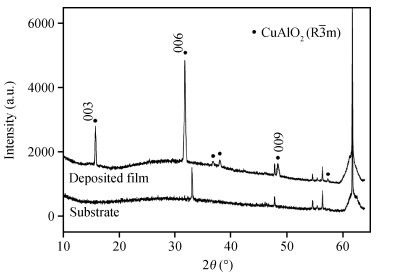
 DownLoad:
DownLoad:
